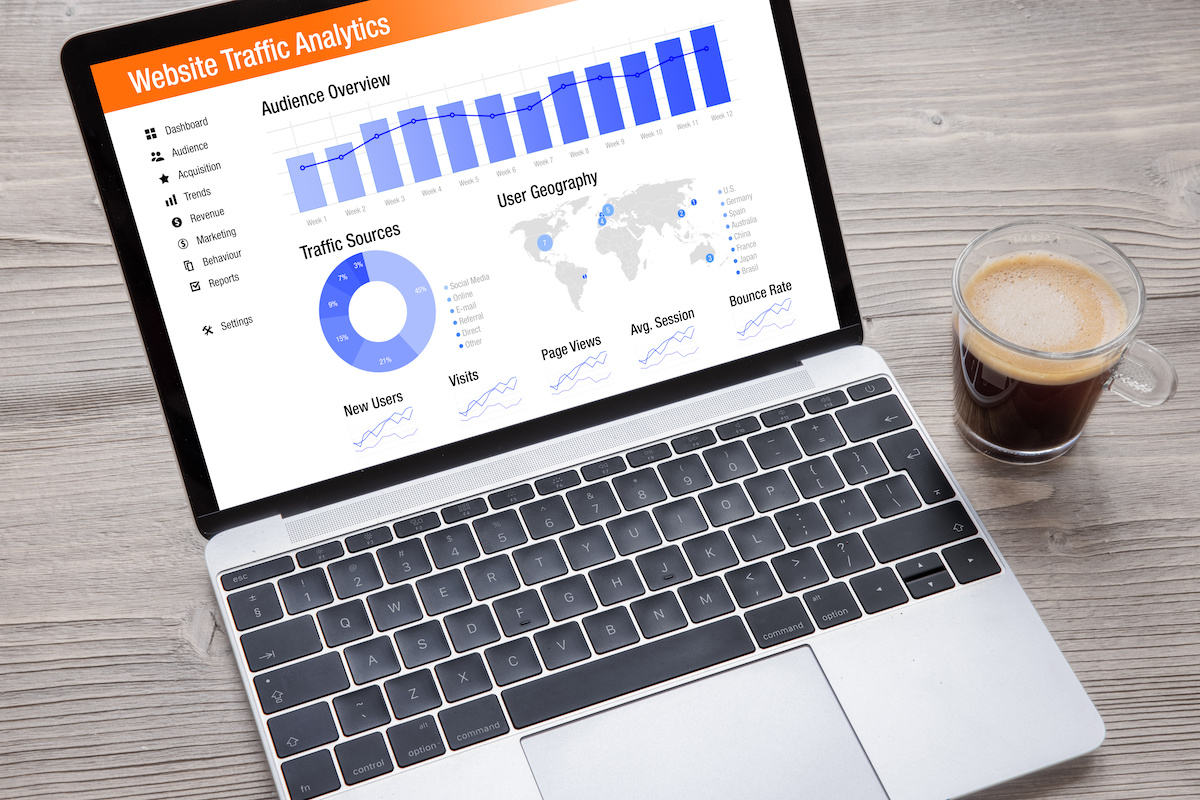
Data is the key to making informed marketing decisions. Whether you’re running a small business or managing a large enterprise, use Google Analytics. It is one of the most powerful tools available for tracking and improving your marketing strategy. It provides insights into your website traffic, user behavior, and the performance of your campaigns, allowing you to refine your marketing efforts for better results.
In this article, we’ll dive into how to use Google Analytics effectively to improve your marketing strategy, from understanding basic metrics to leveraging advanced features for more nuanced insights.
1. Understanding the Basics: Key Metrics and Reports
Before you can use Google Analytics to improve your marketing strategy, it’s important to get familiar with the key metrics and reports it offers.
Sessions
A session represents the entire time a user spends on your site during a single visit. It’s a critical metric for understanding how many people are interacting with your website within a given period.
Users
The number of unique visitors to your site is tracked under “Users.” This metric helps you gauge the reach of your website by showing how many distinct individuals are visiting.
Pageviews
Pageviews tell you how many times pages on your site were viewed. You can see which pages are the most popular and identify trends in user behavior.
Bounce Rate
The bounce rate refers to the percentage of visitors who leave your site after viewing only one page. A high bounce rate is because visitors aren’t finding what they’re looking for or that your landing pages need improvement.
Conversion Rate
The conversion rate is the percentage of users who complete a desired action, such as filling out a form, making a purchase, or subscribing to a newsletter. This metric is crucial for measuring the effectiveness of your marketing campaigns and landing pages.
Traffic Sources
Understanding where your traffic comes from is vital. Google Analytics breaks down traffic into several categories:
- Organic Search: Visitors who found your site through search engines like Google.
- Direct Traffic: Users who typed your URL directly into their browser.
- Referral Traffic: Visitors who came from other websites linking to your site.
- Social Traffic: Users who landed on your site through social media platforms.
- Paid Search: Traffic generated from paid ads on search engines.
These traffic sources help you determine which marketing channels are performing well and where to focus your efforts.

2. Setting Up Goals and Conversion Tracking
To truly make the most of Google Analytics, then you need to set up goals that align with your marketing objectives. Goals represent key actions you want users to take on your site, and tracking them allows you to measure your marketing success.
Types of Goals
There are four types of goals you can set up in Google Analytics:
- Destination Goals: These track when users visit a specific page, like a thank-you page after submitting a form.
- Duration Goals: These goals track how long visitors stay on your site. For example, you might want to track users who stay longer than 5 minutes, indicating deep engagement.
- Pages/Screens per Session: This goal tracks how many pages users visit in a single session, which can be useful for understanding user engagement.
- Event Goals: Events can be any interaction, such as video plays, file downloads, or form submissions. Setting up event goals allows you to track these specific actions.
Once your goals are in place, Google Analytics will provide data on conversion rates, helping you understand which parts of your website and marketing campaigns are driving the most successful outcomes.
3. Using Audience Insights for Targeted Marketing
Google Analytics offers deep insights into your audience demographics, interests, and behaviors, which can help you tailor your marketing strategy.
Demographics and Interests
The Demographics report provides information about the age and gender of your site visitors, while the Interests report shows the general categories your audience is interested in, such as technology, travel, or entertainment. This information allows you to refine your marketing personas and target ads more effectively.
Behavior Reports
The Behavior reports in Google Analytics reveal how visitors interact with your site. You can see which pages they visit, how long they stay, and the flow of their journey through your site. Analyzing these reports helps you understand which content resonates with your audience and which pages may need improvement.
Geo and Language Data
Knowing where your audience is located and the language they speak is important because it helps you optimize your marketing efforts geographically. If you notice significant traffic from a particular region, you may want to adjust your messaging, language, or advertising focus to cater to that audience.
4. Using Behavior Flow to Improve User Experience
One of the lesser-known but highly valuable features of Google Analytics is the Behavior Flow report. This report visually maps out how users navigate through your site, showing the path they take from one page to another.
Why Behavior Flow Matters
Understanding user paths helps you identify potential roadblocks that might be causing users to leave prematurely. For example, if you notice a significant drop-off on a certain page, it might indicate an issue with the page’s content, load time, or usability. With this information, you can then make necessary changes to improve the user experience and keep visitors on your site longer.
Optimizing Key Pages
Use the Behavior Flow report to focus on optimizing high-traffic pages, such as your homepage, product pages, or blog posts. Improving these pages can increase overall site engagement and conversion rates.
5. Leveraging Custom Dashboards and Reports
Google Analytics provides many built-in reports, but sometimes you need to create custom dashboards and reports to focus on the metrics that matter most to your business.
Creating Custom Dashboards
Custom dashboards allow you to view a tailored selection of metrics in one place. For example, if you’re running a specific marketing campaign, you can create a dashboard that tracks only the metrics related to that campaign, such as traffic sources, conversion rates, and user engagement.
Custom Reports
Custom reports give you the flexibility to drill down into the specific data you need. Then, you can build reports that combine different metrics and dimensions, allowing you to analyze data in unique ways. For instance, you could create a report that shows the performance of mobile users compared to desktop users, giving you insights into how different segments of your audience are interacting with your site.
6. Tracking E-commerce Metrics
If you’re running an online store, Google Analytics can provide valuable insights into your e-commerce performance. By enabling E-commerce Tracking, you can gain visibility into key metrics such as:
- Revenue: The total income generated from sales on your site.
- Transactions: The number of completed purchases.
- Average Order Value (AOV): The average amount of money spent per transaction.
- Product Performance: Data on which products are selling the most and generating the most revenue.
This data allows you to optimize your online store by identifying top-selling products, high-converting traffic sources, and opportunities to improve your checkout process.
7. Using Google Analytics for A/B Testing
A/B testing, also known as split testing, is a crucial component of improving your website and marketing campaigns. Google Analytics integrates seamlessly with Google Optimize, a tool that allows you to run A/B tests directly on your site.
Setting Up A/B Tests
A/B testing involves creating two versions of a page (version A and version B) and showing them to different segments of your audience. By comparing performance metrics such as conversion rates or user engagement, you can determine which version performs better.
Improving Conversions
You can use A/B testing to experiment with different headlines, images, calls-to-action (CTAs), or even entire landing page layouts. The insights gained from these tests can help you make data-driven decisions that improve your conversion rates and overall marketing performance.

8. Using Multi-Channel Funnels for a Holistic View
Google Analytics provides a Multi-Channel Funnels report that shows how different marketing channels work together to drive conversions. Often, users interact with multiple touchpoints before converting. For example, they might click on a Facebook ad, visit your website via organic search, and then finally make a purchase through an email campaign.
Attribution Models
The Multi-Channel Funnels report allows you to see how much credit each marketing channel should receive for conversions. You can choose different attribution models, such as First Interaction (crediting the first touchpoint) or Last Interaction (crediting the last touchpoint), to better understand the customer journey.
Improving Channel Synergy
With this insight, you then can optimize how your marketing channels work together. For instance, if you notice that paid search and social media often assist in conversions, you might allocate more budget to those channels to enhance their contribution to the overall customer journey.
Conclusion
Google Analytics is an indispensable tool for improving your marketing strategy because it provides actionable insights into your website traffic, user behavior, and campaign performance. With the right setup and regular analysis, you can then use this data to refine your marketing efforts, boost conversions, and ultimately achieve better results for your business.
At Hooked Marketing, we specialize in helping businesses use data-driven marketing strategies to grow and thrive. Contact us today to learn how we can help you use Google Analytics to maximize your marketing efforts and drive better results for your business!